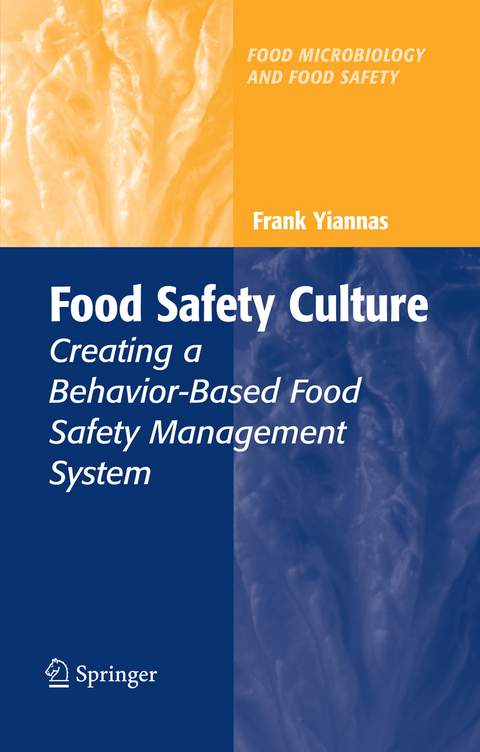
Food Safety Culture
Creating a Behavior-Based Food Safety Management System
Seiten
2010
|
Softcover reprint of hardcover 1st ed. 2009
Springer-Verlag New York Inc.
978-1-4419-2500-8 (ISBN)
Springer-Verlag New York Inc.
978-1-4419-2500-8 (ISBN)
The first significant contribution on how to create a behavior-based food safety management system, this book is intended for food safety professionals in the retail and foodservice industry, as well as quality assurance personnel in a variety of environments.
Food safety awareness is at an all time high, new and emerging threats to the food supply are being recognized, and consumers are eating more and more meals prepared outside of the home. Accordingly, retail and foodservice establishments, as well as food producers at all levels of the food production chain, have a growing responsibility to ensure that proper food safety and sanitation practices are followed, thereby, safeguarding the health of their guests and customers.
Achieving food safety success in this changing environment requires going beyond traditional training, testing, and inspectional approaches to managing risks. It requires a better understanding of organizational culture and the human dimensions of food safety. To improve the food safety performance of a retail or foodservice establishment, an organization with thousands of employees, or a local community, you must change the way people do things. You must change their behavior. In fact, simply put,food safety equals behavior. When viewed from these lenses, one of the most common contributing causes of food borne disease is unsafe behavior (such as improper hand washing, cross-contamination, or undercooking food). Thus, to improve food safety, we need to better integrate food science with behavioral science and use a systems-based approach to managing food safety risk.
The importance of organizational culture, human behavior, and systems thinking is well documented in the occupational safety and health fields. However, significant contributions to the scientific literature on these topics are noticeably absent in the field of food safety.
Food safety awareness is at an all time high, new and emerging threats to the food supply are being recognized, and consumers are eating more and more meals prepared outside of the home. Accordingly, retail and foodservice establishments, as well as food producers at all levels of the food production chain, have a growing responsibility to ensure that proper food safety and sanitation practices are followed, thereby, safeguarding the health of their guests and customers.
Achieving food safety success in this changing environment requires going beyond traditional training, testing, and inspectional approaches to managing risks. It requires a better understanding of organizational culture and the human dimensions of food safety. To improve the food safety performance of a retail or foodservice establishment, an organization with thousands of employees, or a local community, you must change the way people do things. You must change their behavior. In fact, simply put,food safety equals behavior. When viewed from these lenses, one of the most common contributing causes of food borne disease is unsafe behavior (such as improper hand washing, cross-contamination, or undercooking food). Thus, to improve food safety, we need to better integrate food science with behavioral science and use a systems-based approach to managing food safety risk.
The importance of organizational culture, human behavior, and systems thinking is well documented in the occupational safety and health fields. However, significant contributions to the scientific literature on these topics are noticeably absent in the field of food safety.
Frank Yiannas is the Director of Safety and Health at the Walt Disney World Corporation, Kissimmee, Florida.
Looking Back to Shape the Future.- Why the Focus on Culture?.- A Systems-Based Approach to Food Safety.- Creating Food Safety Performance Expectations.- Educating and Training to Influence Behavior.- Communicating Food Safety Effectively.- Developing Food Safety Goals and Measurements.- Using Consequences to Increase or Decrease Behaviors.- Tying It All Together #x2013; Behavior-Based Food Safety Management.- Unwrapping #x2013; Thoughts on the Future of Food Safety.
| Erscheint lt. Verlag | 1.12.2010 |
|---|---|
| Reihe/Serie | Food Microbiology and Food Safety |
| Zusatzinfo | 2 Illustrations, color; 30 Illustrations, black and white; XII, 96 p. 32 illus., 2 illus. in color. |
| Verlagsort | New York, NY |
| Sprache | englisch |
| Maße | 155 x 235 mm |
| Themenwelt | Medizin / Pharmazie ► Gesundheitsfachberufe ► Diätassistenz / Ernährungsberatung |
| Naturwissenschaften ► Biologie ► Biochemie | |
| Technik ► Lebensmitteltechnologie | |
| ISBN-10 | 1-4419-2500-7 / 1441925007 |
| ISBN-13 | 978-1-4419-2500-8 / 9781441925008 |
| Zustand | Neuware |
| Informationen gemäß Produktsicherheitsverordnung (GPSR) | |
| Haben Sie eine Frage zum Produkt? |
Mehr entdecken
aus dem Bereich
aus dem Bereich
Indikation, Diagnostik, Therapie
Buch (2024)
Thieme (Verlag)
80,00 €
Unter Mitarbeit von Walter Burghardt
Buch | Softcover (2020)
Urban & Fischer in Elsevier (Verlag)
56,00 €


